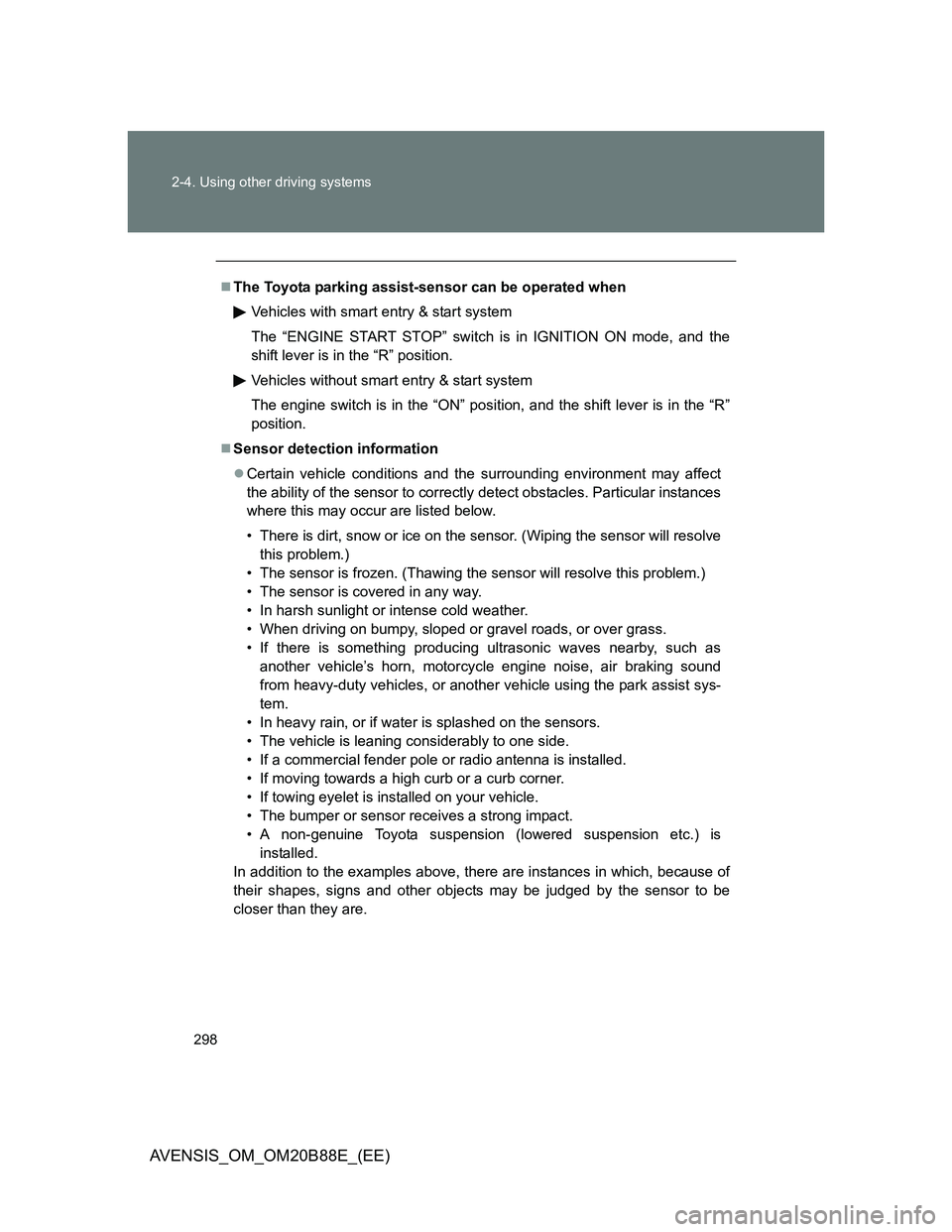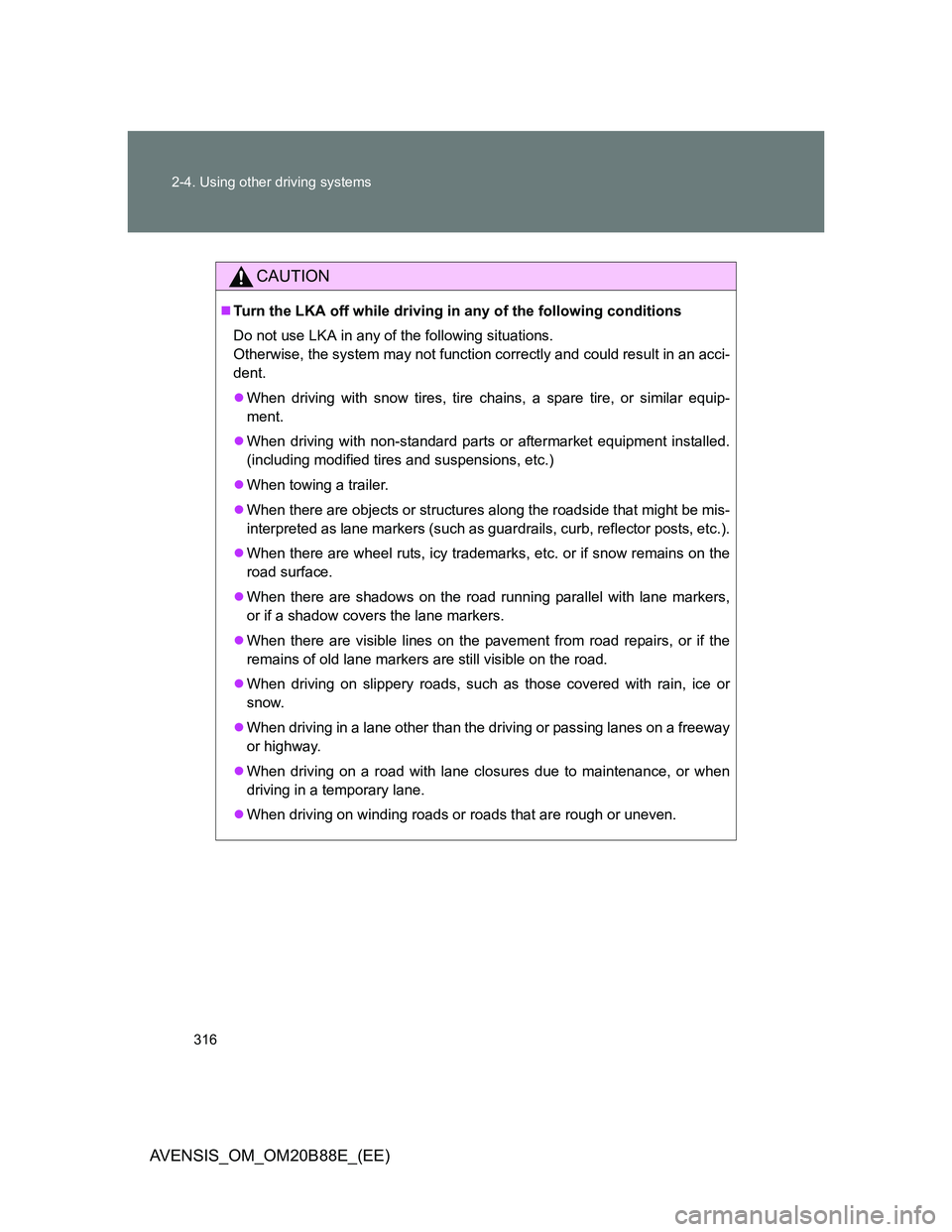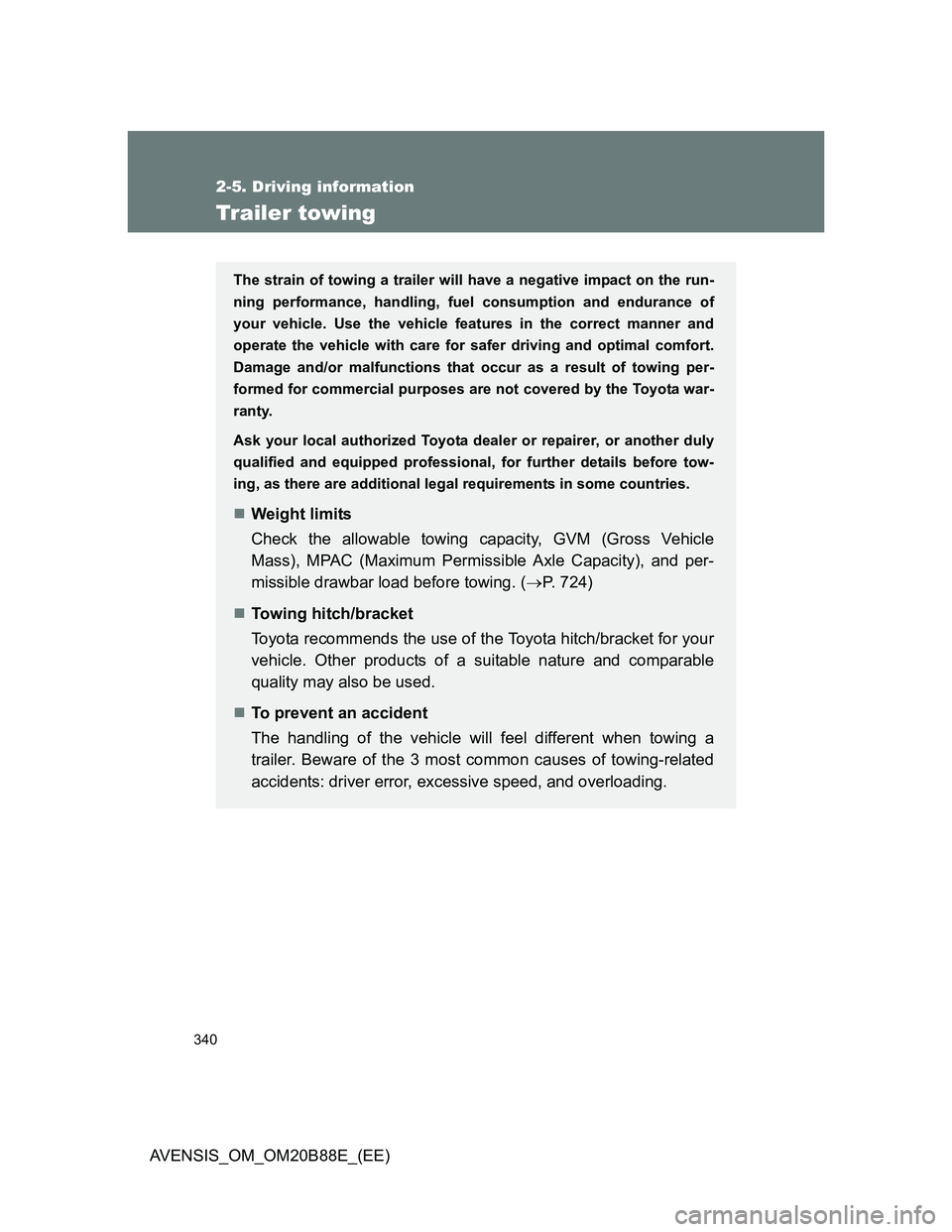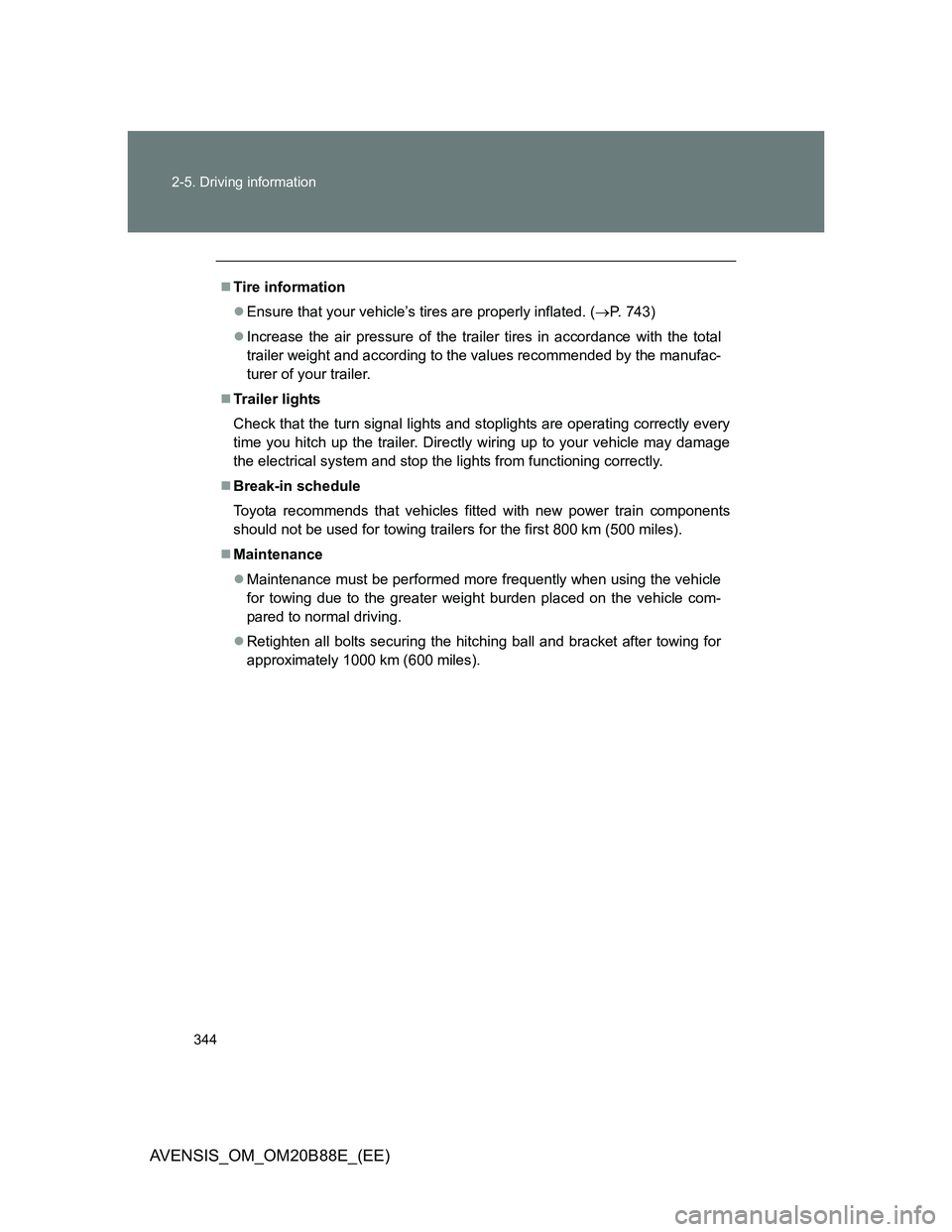Page 298 of 776

298 2-4. Using other driving systems
AVENSIS_OM_OM20B88E_(EE)
The Toyota parking assist-sensor can be operated when
Vehicles with smart entry & start system
The “ENGINE START STOP” switch is in IGNITION ON mode, and the
shift lever is in the “R” position.
Vehicles without smart entry & start system
The engine switch is in the “ON” position, and the shift lever is in the “R”
position.
Sensor detection information
Certain vehicle conditions and the surrounding environment may affect
the ability of the sensor to correctly detect obstacles. Particular instances
where this may occur are listed below.
• There is dirt, snow or ice on the sensor. (Wiping the sensor will resolve
this problem.)
• The sensor is frozen. (Thawing the sensor will resolve this problem.)
• The sensor is covered in any way.
• In harsh sunlight or intense cold weather.
• When driving on bumpy, sloped or gravel roads, or over grass.
• If there is something producing ultrasonic waves nearby, such as
another vehicle’s horn, motorcycle engine noise, air braking sound
from heavy-duty vehicles, or another vehicle using the park assist sys-
tem.
• In heavy rain, or if water is splashed on the sensors.
• The vehicle is leaning considerably to one side.
• If a commercial fender pole or radio antenna is installed.
• If moving towards a high curb or a curb corner.
• If towing eyelet is installed on your vehicle.
• The bumper or sensor receives a strong impact.
• A non-genuine Toyota suspension (lowered suspension etc.) is
installed.
In addition to the examples above, there are instances in which, because of
their shapes, signs and other objects may be judged by the sensor to be
closer than they are.
Page 316 of 776

316 2-4. Using other driving systems
AVENSIS_OM_OM20B88E_(EE)
CAUTION
Turn the LKA off while driving in any of the following conditions
Do not use LKA in any of the following situations.
Otherwise, the system may not function correctly and could result in an acci-
dent.
When driving with snow tires, tire chains, a spare tire, or similar equip-
ment.
When driving with non-standard parts or aftermarket equipment installed.
(including modified tires and suspensions, etc.)
When towing a trailer.
When there are objects or structures along the roadside that might be mis-
interpreted as lane markers (such as guardrails, curb, reflector posts, etc.).
When there are wheel ruts, icy trademarks, etc. or if snow remains on the
road surface.
When there are shadows on the road running parallel with lane markers,
or if a shadow covers the lane markers.
When there are visible lines on the pavement from road repairs, or if the
remains of old lane markers are still visible on the road.
When driving on slippery roads, such as those covered with rain, ice or
snow.
When driving in a lane other than the driving or passing lanes on a freeway
or highway.
When driving on a road with lane closures due to maintenance, or when
driving in a temporary lane.
When driving on winding roads or roads that are rough or uneven.
Page 334 of 776
334
AVENSIS_OM_OM20B88E_(EE)
2-5. Driving information
Cargo and luggage
CAUTION
Things that must not be carried in the trunk/luggage compartment
The following things may cause a fire if loaded in the trunk/luggage compart-
ment.
Receptacles containing gasoline
Aerosol cans
Take notice of the following information about storage precautions,
cargo capacity and load.
Stow cargo and luggage in the trunk/luggage compartment
whenever possible.
Be sure all items are secured in place.
Be careful to keep the vehicle level. Placing the weight as far for-
ward as possible helps maintain vehicle balance.
For better fuel economy, do not carry unnecessary weight.
Page 340 of 776

340
2-5. Driving information
AVENSIS_OM_OM20B88E_(EE)
Trailer towing
The strain of towing a trailer will have a negative impact on the run-
ning performance, handling, fuel consumption and endurance of
your vehicle. Use the vehicle features in the correct manner and
operate the vehicle with care for safer driving and optimal comfort.
Damage and/or malfunctions that occur as a result of towing per-
formed for commercial purposes are not covered by the Toyota war-
ranty.
Ask your local authorized Toyota dealer or repairer, or another duly
qualified and equipped professional, for further details before tow-
ing, as there are additional legal requirements in some countries.
Weight limits
Check the allowable towing capacity, GVM (Gross Vehicle
Mass), MPAC (Maximum Permissible Axle Capacity), and per-
missible drawbar load before towing. (P. 724)
Towing hitch/bracket
Toyota recommends the use of the Toyota hitch/bracket for your
vehicle. Other products of a suitable nature and comparable
quality may also be used.
To prevent an accident
The handling of the vehicle will feel different when towing a
trailer. Beware of the 3 most common causes of towing-related
accidents: driver error, excessive speed, and overloading.
Page 341 of 776
341 2-5. Driving information
2
When driving
AVENSIS_OM_OM20B88E_(EE)
Important points regarding trailer loads
Total trailer weight and permissible drawbar load
Total trailer weight
Weight of the trailer itself plus the
trailer load should be within the
maximum towing capacity.
Exceeding this weight is danger-
ous.
(P. 724)
When the total trailer weight is
greater than the vehicle weight,
we recommend the use of a fric-
tion stabilizer (sway control
device).
Permissible drawbar load
Allocate the trailer load so that
the drawbar load is greater than
25 kg (55.1 lb.) or 4% of the tow-
ing capacity. Do not let the draw-
bar load exceed the indicated
weight. (P. 724)
Page 342 of 776
342 2-5. Driving information
AVENSIS_OM_OM20B88E_(EE)Information tag (manufacturer’s label)
Gross vehicle mass
The combined weight of the
driver, passengers, towing hitch,
total curb mass and drawbar load
should not exceed the gross vehi-
cle mass by more than 100 kg
(220.5 lb.). Exceeding this weight
is dangerous.
Maximum permissible rear
axle capacity
The weight borne by the rear axle
should not exceed the maximum
permissible axle capacity by 15%
or more. Exceeding this weight is
dangerous.
The values for towing capacity
were derived from testing con-
ducted at sea level. Take note
that engine output and towing
capacity will be reduced at high
altitudes.
CAUTION
When the gross vehicle mass limit or maximum permissible axle
capacity is exceeded
Do not exceed the established speed limit for towing a trailer in built-up
areas or 80 km/h (50 mph), whichever is the lower.
Page 343 of 776
343 2-5. Driving information
2
When driving
AVENSIS_OM_OM20B88E_(EE)
Installation positions for the towing hitch/bracket and hitch ball
460.5 mm (18.1 in.)
460.5 mm (18.1 in.)
460.5 mm (18.1 in.)
460.5 mm (18.1 in.)
460.5 mm (18.1 in.)
460.5 mm (18.1 in.)
Sedan: 1111.1 mm (43.7 in.)
Wagon: 1175.5 mm (46.2 in.)
36.2 mm (1.4 in.)
Page 344 of 776

344 2-5. Driving information
AVENSIS_OM_OM20B88E_(EE)
Tire information
Ensure that your vehicle’s tires are properly inflated. (P. 743)
Increase the air pressure of the trailer tires in accordance with the total
trailer weight and according to the values recommended by the manufac-
turer of your trailer.
Trailer lights
Check that the turn signal lights and stoplights are operating correctly every
time you hitch up the trailer. Directly wiring up to your vehicle may damage
the electrical system and stop the lights from functioning correctly.
Break-in schedule
Toyota recommends that vehicles fitted with new power train components
should not be used for towing trailers for the first 800 km (500 miles).
Maintenance
Maintenance must be performed more frequently when using the vehicle
for towing due to the greater weight burden placed on the vehicle com-
pared to normal driving.
Retighten all bolts securing the hitching ball and bracket after towing for
approximately 1000 km (600 miles).